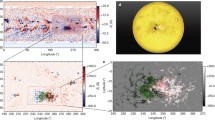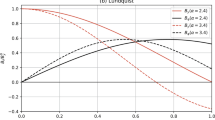Abstract
A flux rope is a domain where a twisted magnetic field [B] is concentrated; it can be described as the core of a singularity of the outer field or the outer vector potential [A] (Kleman and Robbins in Solar Phys. 289, 1173, 2014). This latter case, occurring when the outer field is vanishing, is mathematically analysed for a straight infinite rope. Concepts from condensed-matter physics defect theory are used: the flux [Φ], measured as ∮ C A⋅ds along any loop [C] surrounding the rope, is a topological constant of the theory. A flux rope with a small outer magnetic field can be treated as a perturbation of the above. This theoretical framework allows for the use of classical configurations inside the core, e.g. the linear force-free field (LFFF) Lundquist model or the nonlinear (NLFFF) Gold–Hoyle model, but restricts the number of stable solutions: they are quantised into strata of increasing energies (an infinite number of strata in the first case, only one stratum in the second case); each stratum is defined by a number 2πζ=b/r 0, where b is the periodicity along the axis of the rope and r 0 is its radius, and the rope is made of a continuous set of stable states. We also analyse the merging of identical flux ropes (belonging to the same stratum), with conservation of the relative magnetic helicity: they merge into a unique rope of the first stratum, with a considerable release of energy.
These results might apply to ropes that nucleate in the convection zone and the photosphere, where the magnetic field outside the ropes is weak, and less accurately to the magnetic clouds (MCs) into which they evolve after coronal mass ejections (CMEs) are triggered. However, the lowest LFFF stratum and the unique NLFFF stratum, which numerically come close to each other in this analysis, match the spacecraft data remarkably well.

Similar content being viewed by others
Notes
A right-handed helix carries a positive pitch, a left-handed helix a negative pitch, by convention; this choice implies the use of a right-handed coordinate frame.
We denote any quantity f evaluated at a critical point as \(f|_{r_{0}}\). For example, \(\frac {\partial D}{\partial\eta}|_{r_{0}}=0\).
Use in sequence Equation 11.3.31 (μ=−ν=1) and Equation 9.1.27 (ν=1) from Abramowicz and Stegun (1970).
We give in Equation (29) a closed expression of the relative helicity for a cylindrical tube, which is made possible by its quantised stratum character.
References
Abramowicz, M., Stegun, I.A. (eds.): 1970, Handbook of Mathematical Functions, Dover, New York.
Berger, M.A., Field, G.B.: 1984, The topological properties of magnetic helicity. J. Fluid Mech. 147, 133. DOI .
Cantarella, J., DeTurck, D., Gluck, H.: 2002, Vector calculus and the topology of domains in 3-space. Am. Math. Mon. 109, 409. DOI .
Dasso, S., Mandrini, C.H., Démoulin, P.: 2003, The magnetic helicity of an interplanetary hot flux tube. In: Velli, M., Bruno, R., Malara, F. (eds.) Proc. Tenth Int. Solar Wind Conf. 679, Am. Inst. of Phys., New York, 786.
Dasso, S., Mandrini, C.H., Démoulin, P., Luoni, M.L., Gulisano, A.M.: 2005, Large scale MHD properties of interplanetary magnetic clouds. Adv. Space Res. 35, 711. DOI .
Démoulin, P.: 2014, Evolution of interplanetary coronal mass ejections and magnetic clouds in the heliosphere. In: Schmieder, B., Malherbe, J.M., Wu, S.T. (eds.) Nature of Prominences and Their Role in Space Weather, IAU Symposium 300, 1.
Fan, Y.: 2009, Magnetic fields in the solar convection zone. Living Rev. Solar Phys. 6, 4. DOI .
Georgoulis, M.K., Titov, V.S., Mikić, Z.: 2012, Non neutralized electric current patterns in solar active regions: Origin of the shear-generating Lorentz force. Astrophys. J. 761, 61.
Gold, T., Hoyle, F.: 1960, On the origin of solar flares. Mon. Not. Roy. Astron. Soc. 120, 89.
Griffiths, D.J.: 1999, Introduction to Electrodynamics, 3rd edn. Prentice Hall, New York.
Hood, A.W., Archontis, V., MacTaggart, D.: 2012, 3D MHD flux emergence experiments: Idealized models and coronal interactions. Solar Phys. 278, 3. DOI .
Kleman, M., Friedel, J.: 2008, Disclinations, dislocations and continuous defects: A reappraisal. Rev. Mod. Phys. 80, 61. DOI .
Kleman, M., Robbins, J.M.: 2014, Tubes of magnetic flux and electric current in space physics. Solar Phys. 289, 1173. DOI .
Lepping, R.P., Burlaga, L.F., Szabo, A., Ogilvie, K.W., Mish, W.H., Vassiliadis, D., Lazarus, A.J., Steinberg, J.T., Farrugia, C.J., Janoo, L., Mariani, F.: 1997, The Wind magnetic cloud and events of October 18 – 20, 1995: Interplanetary properties and as triggers for geomagnetic activity. J. Geophys. Res. 102, 14049. DOI .
Linton, M.G.: 2006, Reconnection of nonidentical flux tubes. J. Geophys. Res. 111, A12S09. DOI .
Lundquist, S.: 1950, Magnetohydrostatic fields. Ark. Fys. 2, 361.
MacTaggart, D., Haynes, A.L.: 2014, On magnetic reconnection and flux rope topology in solar flux emergence. Mon. Not. Roy. Astron. Soc. 438, 1500. DOI .
Mahajan, S.M., Yoshida, Z.: 1998, Double curl Beltrami flow: Diamagnetic structures. Phys. Rev. Lett. 81, 4863. DOI .
Melrose, D.B.: 1996, Reply to comments by E.N. Parker. Astrophys. J. 471, 497.
Möstl, C., Farrugia, C.J., Biernat, H.K., Leitner, M., Kilpua, E.K.J., Galvin, A.B., Luhmann, J.G.: 2009, Optimized Grad–Shafranov reconstruction of a magnetic cloud using STEREO-Wind observations. Solar Phys. 256, 427. DOI .
Parker, E.N.: 1979, Cosmical Magnetic Fields, Clarendon, Oxford, 208.
Parker, E.N.: 1996, Inferring mean electric currents in unresolved fibril magnetic fields. Astrophys. J. 471, 485. DOI .
Parker, E.N.: 2004, Tangential discontinuities in untidy magnetic topology. Phys. Plasmas 11, 2328.
Parker, E.N.: 2009, Solar magnetism: The state of our knowledge and ignorance. Space Sci. Rev. 144, 15.
Patsourakos, S., Vourlidas, A., Stenborg, G.S.: 2013, Direct evidence for a fast coronal mass ejection driven by the prior formation and subsequent destabilization of a magnetic flux rope. Astrophys. J. 764, 125. DOI .
Priest, E., Forbes, T.: 2000, Magnetic Reconnection: MHD Theory and Applications, Cambridge University Press, Cambridge.
Schmieder, B., Démoulin, P., Aulanier, G.: 2013, Solar filament eruptions and their physical role in triggering coronal mass ejections. Adv. Space Res. 51, 1967. DOI .
Stenflo, J.O.: 1978, The measurement of solar magnetic fields. Rep. Prog. Phys. 41, 865. DOI .
Török, T., Leake, J.E., Titov, V.S., Archontis, V., Mikić, Z., Linton, M.G., Dalmasse, K., Aulanier, G., Kliem, B.: 2014, Distribution of electric currents in solar active regions. Astrophys. J. Lett. 782, L10. DOI .
Vourlidas, A.: 2014, The flux rope nature of coronal mass ejections. Plasma Phys. Control. Fusion 56, 064001.
Acknowledgements
I am indebted to J.M. Robbins for long-lasting fruitful exchanges on the space physics of electromagnetism. I thank P. Démoulin for pointing out to me the possible relevance of the flux tube singularity theory to magnetic clouds, and for useful correspondence. Both made relevant remarks on the text. I am grateful to J.-L. Le Mouël, who read the manuscript with the utmost care and with whom I have had fruitful discussions. I am also very grateful to the anonymous referee for very valuable remarks. This is IPGP contribution No. 3382.
Author information
Authors and Affiliations
Corresponding author
Rights and permissions
About this article
Cite this article
Kleman, M. Flux Ropes as Singularities of the Vector Potential. Sol Phys 290, 707–725 (2015). https://doi.org/10.1007/s11207-015-0647-6
Received:
Accepted:
Published:
Issue Date:
DOI: https://doi.org/10.1007/s11207-015-0647-6




